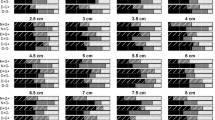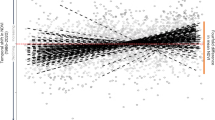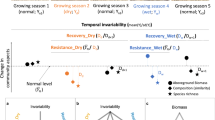Abstract
Plant biomass tends to increase under nutrient addition and decrease under drought. Biotic and abiotic factors influence responses to both, making the combined impact of nutrient addition and drought difficult to predict. Using a globally distributed network of manipulative field experiments, we assessed grassland aboveground biomass response to both drought and increased nutrient availability at 26 sites across nine countries. Overall, drought reduced biomass by 19% and nutrient addition increased it by 24%, resulting in no net impact under combined drought and nutrient addition. Among the plant functional groups, only graminoids responded positively to nutrients during drought. However, these general responses depended on local conditions, especially aridity. Nutrient effects were stronger in arid grasslands and weaker in humid regions and nitrogen-rich soils, although nutrient addition alleviated drought effects the most in subhumid sites. Biomass responses were weaker with higher precipitation variability. Biomass increased more with increased nutrient availability and declined more with drought at high-diversity sites than at low-diversity sites. Our findings highlight the importance of local abiotic and biotic conditions in predicting grassland responses to anthropogenic nutrient and climate changes.
This is a preview of subscription content, access via your institution
Access options
Access Nature and 54 other Nature Portfolio journals
Get Nature+, our best-value online-access subscription
$32.99 / 30 days
cancel any time
Subscribe to this journal
Receive 12 digital issues and online access to articles
$119.00 per year
only $9.92 per issue
Buy this article
- Purchase on SpringerLink
- Instant access to full article PDF
Prices may be subject to local taxes which are calculated during checkout





Similar content being viewed by others
Data availability
All data, including the measured biomass in the studied grasslands, as well as the applied biotic and abiotic data used for analysis, are available via figshare at https://doi.org/10.6084/m9.figshare.27249012 (ref. 59).
Code availability
The R code used for analysis is available via figshare at https://doi.org/10.6084/m9.figshare.27249012 (ref. 59).
References
Naumann, G. et al. Global changes in drought conditions under different levels of warming. Geophys. Res. Lett. 45, 3285–3296 (2018).
Seabloom, E. W. et al. Increasing effects of chronic nutrient enrichment on plant diversity loss and ecosystem productivity over time. Ecology 102, e03218 (2020).
DeMalach, N., Zaady, E. & Kadmon, R. Contrasting effects of water and nutrient additions on grassland communities: a global meta‐analysis. Glob. Ecol. Biogeogr. 26, 983–992 (2017).
Yahdjian, L., Gherardi, L. & Sala, O. E. Nitrogen limitation in arid-subhumid ecosystems: a meta-analysis of fertilization studies. J. Arid. Environ. 75, 675–680 (2011).
Knapp, AlanK. et al. Pushing precipitation to the extremes in distributed experiments: recommendations for simulating wet and dry years. Glob. Chang. Biol. 23, 1774–1782 (2017).
Smith, M. D. et al. Extreme drought impacts have been underestimated in grasslands and shrublands globally. Proc. Natl Acad. Sci. USA 121, e2309881120 (2024).
Fay, P. A. et al. Grassland productivity limited by multiple nutrients. Nat. Plants 1, 15080 (2015).
Chieppa, J., Nielsen, U. N., Tissue, D. T. & Power, S. A. Drought and phosphorus affect productivity of a mesic grassland via shifts in root traits of dominant species. Plant Soil 444, 457–473 (2019).
Van Sundert, K. et al. Fertilized graminoids intensify negative drought effects on grassland productivity. Glob. Chang. Biol. 27, 2441–2457 (2021).
Lü, X. T. & Han, X. G. Nutrient resorption responses to water and nitrogen amendment in semi-arid grassland of Inner Mongolia, China. Plant Soil 327, 481–491 (2010).
Mariotte, P. et al. Plant uptake of nitrogen and phosphorus among grassland species affected by drought along a soil available phosphorus gradient. Plant Soil 448, 121–132 (2020).
Luo, Y. et al. Nitrogen addition alleviates the adverse effects of drought on plant productivity in a temperate steppe. Ecol. Appl. https://doi.org/10.1002/eap.2969 (2024).
Jentsch, A. & White, P. S. A theory of pulse dynamics and disturbance in ecology. Ecology 100, e02734 (2019).
Kiene, C., Jung, E. Y. & Engelbrecht, B. M. J. Nutrient effects on drought responses vary across common temperate grassland species. Oecologia 202, 1–14 (2023).
Kübert, A. et al. Nitrogen loading enhances stress impact of drought on a semi-natural temperate grassland. Front. Plant Sci. 10, 1051 (2019).
Nogueira, C. et al. Nutrient addition and drought interact to change the structure and decrease the functional diversity of a Mediterranean grassland. Front. Ecol. Evol. 6, 155 (2018).
Kreyling, J. et al. Drought effects in climate change manipulation experiments: quantifying the influence of ambient weather conditions and rain-out shelter artifacts. Ecosystems 20, 301–315 (2017).
Wilfahrt, P. A. et al. Disentangling climate from soil nutrient effects on plant biomass production using a multispecies phytometer. Ecosphere https://doi.org/10.1002/ecs2.3719 (2021).
Hoover, D. L., Pfennigwerth, A. A. & Duniway, M. C. Drought resistance and resilience: the role of soil moisture–plant interactions and legacies in a dryland ecosystem. J. Ecol. 109, 3280–3294 (2021).
Bondaruk, V. F. et al. Forage provision is more affected by droughts in arid and semi‐arid than in mesic rangelands. J. Appl. Ecol. 59, 2404–2418 (2022).
Isbell, F. et al. High plant diversity is needed to maintain ecosystem services. Nature 477, 199–202 (2011).
Hautier, Y. et al. Anthropogenic environmental changes affect ecosystem stability via biodiversity. Science 348, 336–340 (2015).
Zeiter, M., Stampfli, A. & Newbery, D. M. Recruitment limitation constrains local species richness and productivity in dry grassland. Ecology 87, 942–951 (2006).
Eskelinen, A., Harpole, W. S., Jessen, M. T., Virtanen, R. & Hautier, Y. Light competition drives herbivore and nutrient effects on plant diversity. Nature 611, 301–305 (2022).
Lee, M. A., Manning, P., Walker, C. S. & Power, S. A. Plant and arthropod community sensitivity to rainfall manipulation but not nitrogen enrichment in a successional grassland ecosystem. Oecologia 176, 1173–1185 (2014).
Zhao, Q., Guo, J., Shu, M., Wang, P. & Hu, S. Impacts of drought and nitrogen enrichment on leaf nutrient resorption and root nutrient allocation in four Tibetan plant species. Sci. Total Environ. 723, 138106 (2020).
Yahdjian, L. et al. Why coordinated distributed experiments should go global. BioScience https://doi.org/10.1093/biosci/biab033 (2021).
Keller, A. B. et al. Stronger fertilization effects on aboveground versus belowground plant properties across nine U.S. grasslands. Ecology 104, e3891 (2023).
Zuo, X. et al. Drought‐driven shifts in relationships between plant biodiversity and productivity in temperate steppes. Funct. Ecol. 36, 2917–2928 (2022).
Smith, M. D., Knapp, A. K. & Collins, S. L. A framework for assessing ecosystem dynamics in response to chronic resource alterations induced by global change. Ecology 90, 3279–3289 (2009).
Shaver, G. R. et al. Global warming and terrestrial ecosystems: a conceptual framework for analysis: ecosystem responses to global warming will be complex and varied. Ecosystem warming experiments hold great potential for providing insights on ways terrestrial ecosystems will respond to upcoming decades of climate change. Documentation of initial conditions provides the context for understanding and predicting ecosystem responses. Bioscience 50, 871–882 (2000).
Bharath, S. et al. Nutrient addition increases grassland sensitivity to droughts. Ecology 101, e02981 (2020).
Carlsson, M., Merten, M., Kayser, M., Isselstein, J. & Wrage-Mönnig, N. Drought stress resistance and resilience of permanent grasslands are shaped by functional group composition and N fertilization. Agric. Ecosyst. Environ. https://doi.org/10.1016/j.agee.2016.11.009 (2017).
Borer, E. T. et al. Nutrients cause grassland biomass to outpace herbivory. Nat. Commun. 11, 6036 (2020).
Borer, E. T. et al. Herbivores and nutrients control grassland plant diversity via light limitation. Nature 508, 517–520 (2014).
Morgan, J. W. et al. Global changes in drought conditions under different levels of warming. Geophys. Res. Lett. 45, 3285–3296 (2018).
Kübert, A. et al. Combined experimental drought and nitrogen loading: the role of species-dependent leaf level control of carbon and water exchange in a temperate grassland. Plant Biol. 23, 427–437 (2021).
Marino, D. et al. Nitrogen fixation control under drought stress. Localized or systemic? Plant Physiol. 143, 1968–1974 (2007).
Mackie, K. A., Zeiter, M., Bloor, J. M. G. & Stampfli, A. Plant functional groups mediate drought resistance and recovery in a multisite grassland experiment. J. Ecol. 107, 937–949 (2019).
Pérez-Camacho, L. et al. Plant functional trait responses to interannual rainfall variability, summer drought and seasonal grazing in Mediterranean herbaceous communities. Funct. Ecol. 26, 740–749 (2012).
Walter, J. et al. Increased rainfall variability reduces biomass and forage quality of temperate grassland largely independent of mowing frequency. Agric. Ecosyst. Environ. 148, 1–10 (2012).
Gherardi, L. A. & Sala, O. E. Effect of interannual precipitation variability on dryland productivity: a global synthesis. Glob. Chang. Biol. 25, 269–276 (2019).
Novoplansky, A. & Goldberg, D. E. Effects of water pulsing on individual performance and competitive hierarchies in plants. J. Veg. Sci. 12, 199–208 (2001).
Chesson, P. et al. Resource pulses, species interactions, and diversity maintenance in arid and semi-arid environments. Oecologia 141, 236–253 (2004).
Ingrisch, J., Umlauf, N. & Bahn, M. Functional thresholds alter the relationship of plant resistance and recovery to drought. Ecology 104, e3907 (2023).
Vogel, A., Scherer-Lorenzen, M. & Weigelt, A. Grassland resistance and resilience after drought depends on management intensity and species richness. PLoS ONE https://doi.org/10.1371/journal.pone.0036992 (2012).
De Boeck, H. J. et al. Patterns and drivers of biodiversity–stability relationships under climate extremes. J. Ecol. 106, 890–902 (2018).
Schenk, H. J. Root competition: beyond resource depletion. J. Ecol. 94, 725–739 (2006).
Craven, D. et al. Plant diversity effects on grassland productivity are robust to both nutrient enrichment and drought. Philos. Trans. R. Soc. B https://doi.org/10.1098/rstb.2015.0277 (2016).
Carbonell‐Silletta, L. et al. Nitrogen rather than water availability limits aboveground primary productivity in an arid ecosystem: substantial differences between grasses and shrubs. Ecohydrology 17, e2636 (2024).
Yahdjian, L. & Sala, O. E. A rainout shelter design for intercepting different amounts of rainfall. Oecologia 133, 95–101 (2002).
Le Houérou, H. N. Climate change, drought and desertification. J. Arid. Environ. 34, 133–185 (1996).
Poggio, L. et al. SoilGrids 2.0: producing soil information for the globe with quantified spatial uncertainty. Soil 7, 217–240 (2021).
Harpole, W. S. et al. Nutrient co‐limitation of primary producer communities. Ecol. Lett. 14, 852–862 (2011).
Brooks, M. E. et al. glmmTMB balances speed and flexibility among packages for zero-inflated generalized linear mixed modeling. R J. 9, 378–400.31 (2017).
Hartig, F. DHARMa: residual diagnostics for hierarchical (multi-level/mixed) regression models. R package version 0.4.6. http://florianhartig.github.io/DHARMa/ (2022).
Lüdecke, D. ggeffects: tidy data frames of marginal effects from regression models. J. Open Source Softw. 3, 772 (2018).
Abatzoglou, J. T. Development of gridded surface meteorological data for ecological applications and modelling. Int. J. Climatol. 33, 121–131 (2013).
Bondaruk et al. First year biomass NPK-D Network (datasets and R code files). figshare https://doi.org/10.6084/m9.figshare.27249012 (2024).
Acknowledgements
This work used data from NPK-D Net (https://www.bayceer.uni-bayreuth.de/npkd/index.php?lang=en) experiment, funded at the site level by individual researchers following protocols from the Nutrient Network (http://www.nutnet.org) experiment and Drought-Net (https://droughtnet.weebly.com/). Q.Y. and his working collaboration group received funding from the National Key R&D Program of China (2022YFE0128000, 2022YFF1300603), the National Natural Science Foundation of China (32171592, 32061123005) and the Scientific and Technological Innovation Project of China Academy of Chinese Medical Sciences (CI2024C003YN). V.F.B. thanks the Alexander von Humboldt Foundation for the Georg Forster Research Fellowship that provided the support necessary to complete most of this work during her research stay at the University of Bayreuth, Germany. L.Y. acknowledges PICT 2019-02324 from the National Agency of Scientific Promotion. A.J. received funding from the Federal Ministry of Education and Research Germany (BMBF, FKZ 031B1067C). E.W.S., E.T.B., F.I. and J.G. acknowledge support by grants from the National Science Foundation Research Coordination Network (NSF-DEB-1042132) and Long-Term Ecological Research (NSF-DEB-1234162 and NSF-DEB-1831944 to Cedar Creek LTER) programmes and the Institute on the Environment (DG-0001-13). They thank P.W. and A. Asmus for data coordination and management. M.D.S. was supported by a National Science Foundation (NSF) Research Coordination Network grant (DEB-1354732), US Department of Agriculture’s National Institute of Food and Agriculture (USDA-NIFA) Postdoctoral Fellowship grant (2020-67034-31898), USDA-NIFA Conference Grant (2020-67019-31757), US Geological Survey John Wesley Powell Center for Analysis and Synthesis grant, US Geological Survey grant (G21AC10266-00), and a Global Drought Synthesis Group grant funded by the NSF Long-term Ecological Research Network Office (LNO) and the National Center for Ecological Analysis and Synthesis, University of California-Santa Barbara. J.A. and P.D. acknowledge grants from CONICET, FONCyT and UNMdP. H.A. received funding from the Helmholtz-Centre for Environmental Research - UFZ and thanks the staff of the Bad Lauchstädt Research Station for maintaining the plots and infrastructures. N.E. received support from iDiv funded by the German Research Foundation (DFG– FZT 118, 202548816). A.C.G., E.V. and G.M.W. received funding from the Hermon Slade Foundation (HSF 19103) and the Australian National Landcare Program: DigiFarm, the Holsworth Wildlife Research Endowment, and they thank the staff at the Narrabri Plant Breeding Institute for site maintenance. Y.M. and M.T. acknowledge support from a grant from the National Research Foundation (grant no: 116262). Y.H. thanks the Dutch state forestry (Staatsbosbeheer) for providing access to the study site.
Author information
Authors and Affiliations
Contributions
Y.H. and Q.Y. developed and framed the research question. Y.H., A.J., Q.Y., L.Y., E.T.B., E.W.S. and M.D.S. coordinated the NPK-D Net collaboration. V.F.B. and C.X. led the writing of the paper. V.F.B., G.R.O. and H.D. analysed data. C.X., P.W., J.A., M.C., A.K., S.A.P., T.O. and L.B. contributed to data analysis. P.W., L.Y., Q.Y., E.T.B., A.J., E.W.S., J.A., G.R.O., H.D., M.C., A.K., S.A.P., N.E., F.I., H. Auge, M.H.C., A.C.C., P.D., T.F., A.C.G., S.E.K., T.O., P.P., A.P., D.S., M.T., A.V., E.V., G.M.W., C.W. and G.R.W. contributed to writing the paper. V.F.B., C.X., A.J., J.A., M.C., A.K., S.A.P., N.E., F.I., H. Auge, M.H.C., A.C.C., P.D., T.F., A.C.G., S.E.K., P.P., A.P., D.S., M.T., A.V., E.V., G.M.W., C.W., G.W., H. An, H.J.D., J.G., L.B.H., Y.G.K., J.L.L., Y.M., D.S.T., D.T., S.W., C.Z.W., K.W., H.H.W., A.Y., F.W.Z., B.Z., J.Z., N.Z. and X.Z. contributed to data collection and were site-level coordinators. Further details of each author’s contribution can be found in Supplementary Table 10.
Corresponding author
Ethics declarations
Competing interests
The authors declare no competing interests.
Peer review
Peer review information
Nature Ecology & Evolution thanks Dafeng Hui and the other, anonymous, reviewer(s) for their contribution to the peer review of this work.
Additional information
Publisher’s note Springer Nature remains neutral with regard to jurisdictional claims in published maps and institutional affiliations.
Supplementary information
Supplementary Information
Supplementary Figs. 1–5 and Tables 1–10.
Rights and permissions
Springer Nature or its licensor (e.g. a society or other partner) holds exclusive rights to this article under a publishing agreement with the author(s) or other rightsholder(s); author self-archiving of the accepted manuscript version of this article is solely governed by the terms of such publishing agreement and applicable law.
About this article
Cite this article
Bondaruk, V.F., Xu, C., Wilfahrt, P. et al. Aridity modulates grassland biomass responses to combined drought and nutrient addition. Nat Ecol Evol 9, 937–946 (2025). https://doi.org/10.1038/s41559-025-02705-8
Received:
Accepted:
Published:
Issue date:
DOI: https://doi.org/10.1038/s41559-025-02705-8



